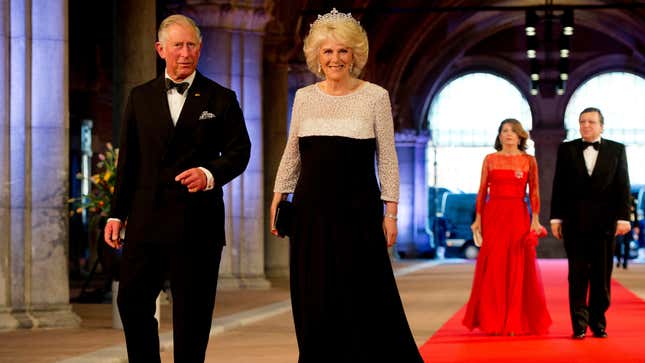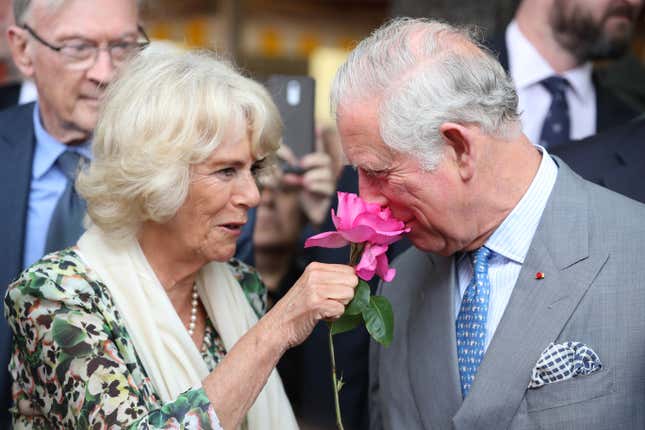How The Crown Undid Charles and Camilla's Decade-Long Rehabilitation
In Depth

The Crown is a problem for the Crown. Now in its fourth season the show, which takes as its subject the intertwined stories of Queen Elizabeth II’s life and the course of the 20th-century monarchy, is finally tackling the destructive public scandals of the 1990s—particularly the implosion of her heir’s first marriage. Peter Morgan and his lavishly gloomy drama have now enthusiastically begun to depict the failed fairy tale that was the marriage of Charles and Diana, Prince and Princess of Wales, and in the process, the wildly popular series threatens to jeopardize years and years of careful Palace work to rehabilitate the reputations of Charles, Camilla, and the institution itself. They’ve done their best to put the past behind them—but Netflix is beaming that past right back into homes around the world.
Charles and Camilla met in 1971, when he was 22 and she was 24. The best story about their meeting has Camilla cracking a joke about her great-grandmother, Alice Keppel, having been a favorite mistress to his great-great-grandfather Edward VI, but it may be apocryphal; biographer Jonathan Dimbleby says they were introduced by a mutual friend. But the line does sound like the Camilla described by friends—warm and somewhat saucy—and Charles’s most recent biographer, the well-sourced Sally Bedell Smith, says that Camilla was proud of her ancestor and even kept her portrait in her drawing room. Camilla was athletic and outdoorsy, the prototypical country girl, as well as slightly older and more experienced, in a long-running off-again on-again relationship with Charles’s fellow polo player Andrew Parker Bowles (who, at one point, went out with Charles’s sister, Anne). She was, by all accounts, charming and very, very fun.
According to Sally Bedell Smith, the two got involved in 1972, when Andrew Parker Bowles was doing six months of military service in Northern Ireland and Cyprus. But Charles wasn’t ready to settle down, and Camilla quite famously wasn’t considered royal bride material, anyway. Charles’s cousin, Patricia Montbatten, referred to the “obvious problems” with Camilla, i.e. her “history,” which is to say she had—like many modern women of 24—a sexual history that could be dug up and poured over. While on his own tour of military service, in the Navy, Charles was apparently shocked to learn that Camilla and Andrew were getting married.

But that, of course, was absolutely not the end of that. British royal circles are very small, and Charles continued to see the Parker Bowleses socially. The marriage wasn’t going well—Bedell Smith says Parker Bowles was so openly unfaithful that he was known around London as “Andrew Poker Bowles”—and sometime in 1978, Charles and Camilla got back together, discreetly. But she was even less suitable as a potential royal bride now, as a married woman with two children and practically middle-aged by the reproductive-focused standards of monarchy, and Charles wasn’t getting any younger, either. Enter Diana, the perfect princess straight out of central casting.
Charles and Camilla ended their affair, but Diana knew their history, and especially after she found a sort of goodbye bracelet Charles had made for Camilla shortly before their wedding, it put a crack in the not-exactly-bedrock-to-begin-with foundation of their marriage that only widened over time. (Apparently, he had them made for several of his women friends, not just Camilla.) After they were married they socialized with the Parker Bowleses; Charles and Camilla remained friends, and even when they weren’t physical, their longstanding connection haunted the marriage from the very start. Bedell Smith alleges that in fact, Diana was the first to be unfaithful in the marriage; in 1994, Charles essentially admitted to infidelity in a TV interview, but said it came only after their marriage “became irretrievably broken down, us both having tried.” But clearly the shadow of her husband’s relationship with Camilla hung over the marriage even before the sexual affair in fact recommenced (reportedly sometime in 1986), and Diana shaped the public perception of what went wrong in their marriage for the entire world for the foreseeable future with her 1995 Panorama interview, peeking up through her bangs and announcing: “Well, there were three of us in this marriage, so it was a bit crowded.” Not to mention that Camilla made a convenient tabloid foil to the beautiful, vulnerable, publicly beloved Diana; older and less attractive, Camilla was the mistress rendered as evil stepmother in the international media soap opera that followed, bedeviling the young heroine.
Once Charles and Diana divorced in 1996, he didn’t waste time; as Vanity Fair chronicled in 2001, he brought in a new comms person, Mark Bolland, to launch the “Camilla Campaign” to rehabilitate their reputations and put them on a path toward an open life together. Their first appearance together was simply walking from his office to his staff Christmas party in each other’s company—that’s how small they had to start. (The Parker Bowles had divorced in 1995.) Obviously, Diana’s death in 1997 put that plan right back into the deep freeze, but things eventually thawed again. Their first real public appearance as a couple was in 1999, publicly leaving Camilla’s sister’s birthday party together.
Pulling it off required neutralizing the power of the tabloid portray of Camilla, Charles’s former press secretary Colleen Harris told biographer Penny Junor in an excerpt that ran at Vanity Fair: “They’d all made a lot of money out of the story that Camilla was this evil, horrible person who ruined Diana’s life and was ruining the children’s lives, and they wanted that story to continue.” Their task was to wear that narrative down. “The more we made Camilla acceptable, the less the story had traction. The idea was to make her more human without making her more popular than him—we didn’t want any of that rivalry again—to show she was a real person with real feelings and interests.” That was perhaps easier, too, as the spotlight shifted to the younger royals—and without Diana still present. They succeeded.

Eventually, the pair were married in 2005—in a civil ceremony with a church blessing, to keep on the right side of Anglican rules. The palace announced that, when Charles eventually accedes to the throne, she’ll be known as HRH The Princess Consort, a slightly massaged title. (Apparently, Charles dithered about whether they should in fact finally get married, but apparently, Camilla’s father once again stepped in and strongly encouraged him to make it official, and Charles’s private secretary apparently just told him he had to decide one way or the other.) The now-married couple undertook a wide variety of classic royal photo ops that portrayed them in their best light, doing royal tours across the world and also closer to home, such as wandering through markets tasting the wares and cheerfully bantering with locals. Charles loosens up around Camilla and together they make an engaging team, even as she keeps her mouth shut in a broader sense.
Now, of course, it’s an era of renewed royal scandal, which is dredging up the biggest drama of the institution in the 20th century. Charles and Camilla are up against a woman who is both beloved and dead, frozen in time at the height of her international popularity, glamour, and beauty. In an era obsessed with revisiting old news stories with fresh eyes via podcasts and documentaries, The Crown presents an opportunity to rehash perhaps the single biggest gossip story of the 1990s. Previous seasons have inspired an SEO cottage industry around explainers for events depicted on the show; this chapter is even better, since many viewers remember the events firsthand. Since it’s fiction, it also offers the opportunity to imagine—condensed into tight, explosive moments—how it might have all gone wrong behind closed doors. Their Charles, so humanized in the last season, comes off as cruel, weak, and emotionally immature. The show is more sympathetic to Camilla and the dynamic into which she was shoved; the lovely actress they’ve cast delivers a speech telling Charles that if she’s forced into a popularity contest with Diana, she’ll lose, because Diana is a perfect fairy tale heroine, and that stock character is always somehow wronged, making Camilla automatically the wicked witch. But by resurrecting Princess Di in her beautiful prime, the show has put them all right back into that triangle.
What’s more, it’s coming at the worst possible time. Queen Elizabeth II is 94 years old, in the middle of a global pandemic that’s especially hard on the elderly. The Windsors are famously long-lived, but it’s clear to everyone that Charles is finally in the end game, closing in on the period when he will finally take over the job he’s been awaiting his entire life. And the royals in the 21st century rely more than ever on continuing public goodwill. And too, the family has already been rocked by the departure of Harry and Meghan and the very public downfall of Prince Andrew. It’s a terrible time for the ghost of Diana to come knocking, and yet she haunts the Windsors. The Palace is attempting to manage the problem: Prince Charles’s friends have launched a “blistering attack” on The Crown’s depiction of his infamous first marriage, and his office, Clarence House, has turned off replies on Twitter. That won’t be enough to make this problem go away, though.